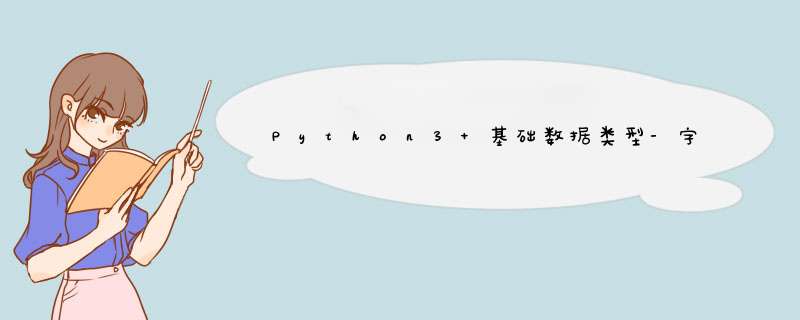
Python3 基础语法-字符串类型及 *** 作
字符串是Python中最常用的数据类型之一。
一、字符串类型基础 1.1 字符串的创建
在Python中使用成对的单引号或成对的双引号创建字符串。使用三对单引号创建多行字符串。
s1 = "hello qianan"
print(s1)
s2 = 'hello qianan'
print(s2)
s3 = '''hello qianan'''
print(s3)注意:所有的单双号都是在英文状态下,并且必须是成对出现。
1.2 字符串的存储方式字符串是不可变的序列数据类型,不能直接修改字符串本身。
字符串类型与数值类型的区别:
num = 200 #数值类型
num1 = "200" #字符串类型实际上,对于数值类型而言,一个字节最大可以存储的数值是256,所以,num就存储在一个字节当中。但是,字符串本身就是序列数据结构,所以num1为“200”的模式是“2”、“0”、“0”分别存储在3个字节当中。
1.3 字符串的下标因为字符串是序列数据结构,所以,当我们要从某条字符串中提取某个字符就要通过索引(默认开始为0):
>>> s1 = "hello world"
>>> s1[1] # 从0开始,1是从左到右第二个
'e'
>>> s1[10]
'd'
>>> s1[-1] # -1就是从右到左倒数第一个
'd'
>>> s1[11] # 超过字符串总长度(10),直接报错
Traceback (most recent call last):
File "", line 1, in
IndexError: string index out of range 为什么说字符串是不可修改类型?下面我从一条字符串中索引一个字符后重新赋值,Python会直接报错:
>>> s2 = "hello world"
>>> s2[4] = 'l'
Traceback (most recent call last):
File "", line 1, in
TypeError: 'str' object does not support item assignment 二、字符串类型的基本 *** 作 2.1 字符串切片
slice()切片:
start:起始位置,默认索引从0开始。
stop:结束位置,默认最后一个元素。
stop:步长,默认为1。
slice()的方法定义:
class slice(object)
slice(stop)
slice(start, stop[, step])
Create a slice object. This is used for extended slicing (e.g. a[0:10:2]).切片实例:
s3 = “hello world” , 如何取出 “world”
代码如下:
>>> s3 = "hello world"
>>> s3[6:10] # 注意,左闭右开
'worl'
>>> s3[6:11]
'world'
>>> s3[6:] # 不写默认取到最后一位
'world'如何取出 “hlowrd” ?
分析发现,它们在字符串s3中,是隔一个取一个,那么需要通过修改步长为2就可实现:
>>> s3[::2]
'hlowrd's3 = “hello world” ,将它逆向(倒叙)输出:
>>> s3[::-1]
'dlrow olleh'2.2 字符串重组
-
使用 + 号直接拼接
print('1'+'2') # 12-
%s、%d、%f
name = 'qianan'
age = 18
print('%s年龄%d'%(name,age)) -
str.format()
name = 'qianan'
age = 18
print('{}年龄{}'.format(name,18))
print('{1}年龄{0}'.format(18,name))-
f'' 引号前加f
name = 'qianan'
age = 18
print(f'{name}的年龄是{age}')三、 字符串常见 *** 作
- S.find(sub) --> 返回该元素最小的索引。
- 实际上,该方法与s.find()实现的功能一样,但是唯一不同的就是当元素不存在时,s.index()方法会报错。所以建议使用s.find()
>>> s4 = 'hello python'
>>> s4.find('e')
1
>>> s4.find('o') # 当元素有多个时,返回最小索引
4
>>> s4.find('c') # 找不到则为-1
-1- S.replace(old, new[, count]) --> 替换
>>> s5 = "hello python"
>>> s5.replace('l','a') # 将'l'替换成'a',全部替换
'heaao python'
>>> s5
'hello python' # 注意:原来的字符串并没有被改变
>>> s5.replace('l','a',1) # 只替换一个,则指定count参数为1即可
'healo python'- S.split(sep=None) --> 以sep来分割字符串,并返回列表。sep默认为None,分割默认为空格
>>> s6 = 'hello everyboby ye!'
>>> s6.split(' ')
['hello', 'everyboby', 'ye!']- S.startswith(prefix[, start[, end]]) --> 判断字符串是否以前缀开始,返回为bool值。
>>> s7 = "hello world"
>>> s7.startswith("he")
True- S.endswith(suffix[, start[, end]]) --> 判断字符串是否以尾缀结束,返回为bool值。
- S.lower() --> 将字符串全部转为小写
- S.upper() --> 将字符串全部转为大写
- S.strip([chars]) --> 默认去掉字符串左右的空格
>>> s8 = ' hello world '
>>> s8.strip()
'hello world'- S.isalpha() --> 判断字符串是否全为字母,返回的是bool值
- S.isdigit() --> 判断字符串是否全为数字,返回的是bool值
- S.isalnum() --> 判断字符串是否全为数字或者字母,不存在特殊字符,返回的是bool值
- S.join(iterable) --> 将序列中的元素以指定的字符连接生成一个新的字符串
li = ["你好","世界"]
s = ','.join(li)
print(s)
欢迎分享,转载请注明来源:内存溢出

 微信扫一扫
微信扫一扫
 支付宝扫一扫
支付宝扫一扫
评论列表(0条)